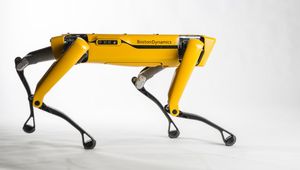PhantomX Hexapod Mark III Robotic Platform and Development Kit
A six-legged robotic platform for developing ground based- mobile robots.
Technical Specifications
| Applications | EdTech, Robotic Development, Research |
| Operation | Remote-controlled, Autonomous |
| Microcontroller | Arduino Compatible ArbotiX Robocontroller |
| Battery | 11.1 V 4500mAh LiPo battery |
| Wireless Control | XBEE Radio via PC |
| Material | Black Anodized Aluminum |
Overview
Arduino-Compatible ArbotiX Robocontroller
The PhantomX Hexapod MKIII kit features the ArbotiX Robocontroller that primarily works with Arduino-based robotic kits. It provides sufficient control and advanced applications from DYNAMIXEL servos and can easily handle up to 16 digital inputs and outputs simultaneously.
It’s mainly designed for servo motors and uses a powerful AVR microcontroller and an XBEE wireless radio module to incorporate remote-controlled applications. Since it’s Arduino-compatible, it can be used via Arduino IDE, allowing users to work with existing libraries and example sketches.
High-Quality Servo Motors and Electronic Modules
Since hexapod robots heavily rely on servo motors, the PhantomX Hexapod features some advanced servo modules such as the DYNAMIXEL and Next-Gen AX servo motor series. An intuitive design allows the servos to control movements like panning, tilting, arm movement, gripping, etc.
The Next-Gen AX servo series features a couple of variations, such as:
AX-12A robotic servo can track speed, temperature, voltage, load, and shaft position. Moreover, the servo actuator can control each connected servo independently, providing better user control.
AX-18A robotic servo also works similarly to the AX-12A, but it has a higher no-load speed (97 rpm) and up to 1.8 Nm stall torque.
Thanks to a distributed control mechanism, the servo mechanism allows better user control. This is particularly useful for servo-mounted sensor-based applications.
The electronic kit also features an 11.1 V 3S 4500mAh LiPo battery and wiring harnesses. There is a battery charging kit and a USB A to mini-B cable. Moreover, the platform has a complete installation guide, so users can set up and start development quickly.
Robust Design with a Material Upgrade for a Stronger Robotic Design
The PhantomX Hexapod MKIII features a significant material upgrade from its previous model. It has a fully metallic aluminum frame, discarding the previously used plastic frames for the servo installations. The legs, body, and components are all black anodized aluminum. Moreover, a bottom battery design adds clarity and convenience of operation for the developers.
Since it’s a sturdy design for robotic applications, it becomes an ideal tool for testing in the lab and outdoor robotic solutions, enabling more accessible and more productive prototyping in the EdTech and industrial research sectors.
PhantomX Hexapod can work as an autonomous or remote-controlled robot with a wide range of indoor and outdoor applications. The servo-based design with additional speed and temperature tracking features also allow developers to deal with motion constraints and make the robot more navigable across different terrains.









